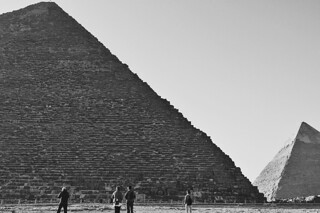 Mijo and I have been wanting to go to Egypt. Finally, it happened and the trip was absolutely unforgettable. Everything I read from books and seen on television were larger than life and the experience was awesome.
Mijo and I have been wanting to go to Egypt. Finally, it happened and the trip was absolutely unforgettable. Everything I read from books and seen on television were larger than life and the experience was awesome.This Pinoy was in travel heaven!
Mijo and I saw the Rosetta Stone at the British Museum when we traveled together in London the last time. The Rosetta Stone contains texts written in three languages including Greek and Ancient Egyptian hieroglyphic and this paved the way to the translation of Ancient Egyptian hieroglyphs in to Greek. If the Rosetta Stone led to the decipherment of Ancient Egyptian hieroglyphs, the Rosetta Stone enboldened Mijo and I to go on a trip to Egypt.
[read my Luxor blog, March 2019]
This was my first glimpse of Egypt. We landed in Cairo at noon and we were whisked right away to our hotel located by the River Nile. We booked this trip as a guided tour with Gate1 Travel because we want the very best and the experts (Shukran to our travel director, Neveen!) in Egyptian history and antiquities to show us around.
There were two groups for this tour. Our small group was whisked to our hotel via a tourist bus with police car escort. I later learned in the trip that we were also assigned one body guard per bus.
Here's the Mariott hotel's lovely and quiet courtyard. The hotel is located in Gezira island in the middle of River Nile in Cairo's Zamalek neighborhood.
The hotel's exquisite lobby is like a lobby of a palace. Speaking of palaces, I also learned that the hotel's main part where the Omar Khayyam casino and the lobby is located used to be the Gezirah Palace.
This is the hotel's engaging garden cafe. Since we arrived late in the afternoon, there was really no time to do any sight seeing on our own. We decided to enjoy the hotel's garden cafe and lounged there while listening to local music. Judging
by the crowd at the garden cafe, it was the place to see and be seen.
Guests look like monied, local celebrity or someone in politics.
The first order of business was food. We ordered this mezze with a local red wine blend called 2016 Omar Khayyam Vin Rouge. The warm pita bread went well with the different kinds of dip.
Though the pyramids were not the first thing we saw during the guided tours, I am mentioning it first in this blog because this is the highlight of the trip for me. Since I am not an expert in Egyptian history and antiquities, I'll just give you a virtual tour.
By this time, we had already seen the other sites in Egypt via a Nile cruise down to Luxor, Edfu and Aswan. The tour company saved the best for last. We went to Giza to see the Great Pyramids of Giza early in the morning before everyone got there. Though the day was sunny, the weather was freezing that time of the year.
The pyramids in the picture below are Pharaoh Khufu's on the left and Pharaoh Khafre's on the right. The pyramids are just awe inspiring from afar and upclose. The pyramids are not just tall, they are massive as well. I got into my never-in-my-wildest-dreams moments as soon as I saw this view. It is hard not to feel small and insignificant next to these structures. I used to read about these pyramids in my grade school and high school history books, and used to see them only on television and movies. And now I'm standing face to face with them? It felt like I stepped inside my books and walking along the historical landmarks. I spent about 5 minutes absorbing the moment and taking it all in before snapping this picture.
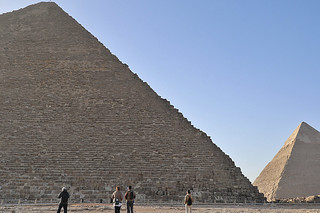
These are the entrances into the Great Pyramid of Khufu. The smaller of the entrances in the picture is where the tourists go in. What we see today, the rugged facade of brick over brick over brick, is the core structure of the pyramids. We were told by our Egyptologist guide that the pyramids used to be covered by smoothed limestone so they gleamed from afar. The limestone casing samples can be seen at the base of the pyramid in this picture.
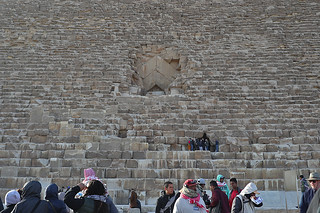
Here's the view of the city of Giza from the Great Pyramids. I can't imagine what this view looked like thousands of years ago when Egypt was at its peak of power.
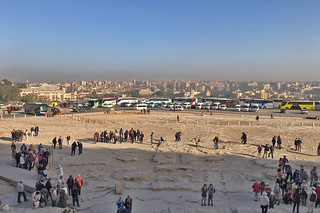
This picture was taken before we went inside the Great Pyramid of Khufu. Look at the size of the stone blocks. Huge blocks! As a systems designer, I am curious how these amazing monuments were built and which design principles were applied. I must say it was a fool proof design because it stood the test of time.
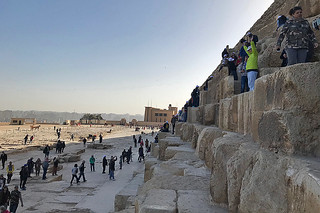
We were told that the construction techniques used to build the pyramids are just hypothesis and that no one really knows how they were put together. I cannot imagine how these huge stone blocks were quarried, carried from the quarry to the construction site, put them on top of each other and then added the smooth limestone casing. And that was using the technology at the time. The fact that these monuments still stand today is a testament to the quality of the design and build.
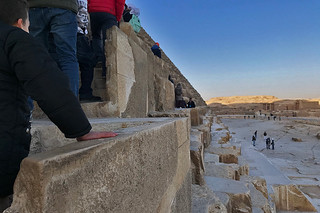
Here's a view of what it's like inside the Great Pyramid of Khufu. It is very cramped inside. If you are afraid of enclosed spaces, I recommend not going inside the pyramid because the galleries are really narrow and lots of people going in and out to see the Pharaoh's chamber up inside the pyramid.
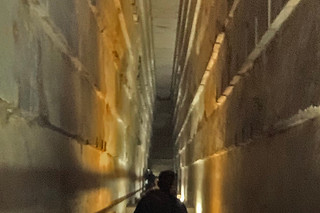
That was an awesome experience! The tour of the Giza Pyramids was actually the last part of the tour package. And I see the point why that is so because this was the highlight of the many highlights in this Egypt tour.
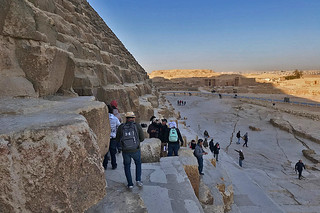
Here's the side view of the Great Pyramid of Khufu. I wanted to walk the length of at least two sides of the pyramid but there was not enough time. There were demanding vendors offering camel rides for a fee. Some are selling miniature souvenir pyramids. If you say no and mean no, they will leave you alone.

Here is a view of Pharaoh Khafre's pyramid from our bus on our way to the next tour activity. We didn't get a chance to check out that pyramid. I am not sure if people are even allowed to wander around that area. The smooth limestone casing is still seen on the top part of the pyramid.
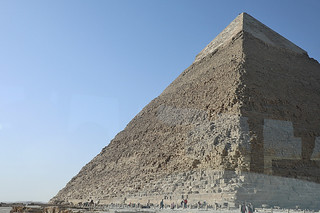
Here is a sweeping view of the Great Pyramids of Giza from afar before our camel ride. This plateau must have seen generations and generations of Egyptians and hundreds, maybe thousands, of stories to tell. Including the one about Moises and the Ten Commandments.
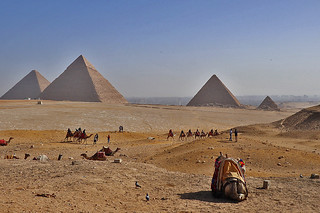
I don't know how to ride a horse and I had never ridden on a camel before so I didn't have any great expectations about this part of the tour. The camels were adorned with what looks like exquisitely designed carpets.
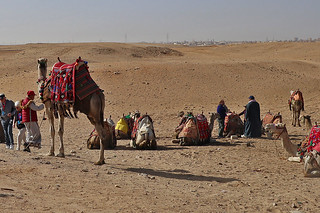
We were each assigned a camel guide. This is to direct the camel to sit, stand up and walk. To get on the camel, the camel would kneel and we were told to lean back when we get on the camel. I wasn't told exactly why that is but as soon as the camel stood up I understood why. It was actually quite dangerous had I not followed their instructions. It was also a good thing I was not the first one in our tour group to get on the camel. I had time to observe.
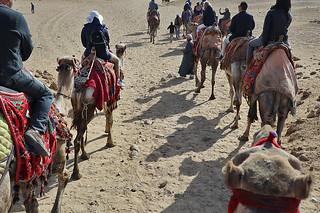
Sitting on the camel was scary for me because I felt like I was sitting pretty high up. Where do you hold on to? There is a hump as part of the seating structure. The camel ride was quite jerky as well which made it difficult to take selfies. I was really sure I was going to fall or get hurt in this part of the trip. Another thing to expect when riding camels - distinctive camel smell and millions of flies.
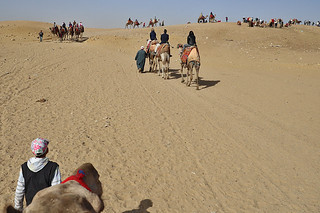
But it ended well because nothing bad happened to me, to Mijo or to any of my group tour mates. In fact, I was getting the hang of it after a few minutes of riding. I was even taking selfies and pictures. Here's a picture of my camel and my shadow. Can I take my camel home to be my pet? I hope the camels are getting the proper care and rest at the end of the day.
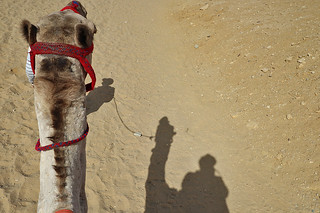
The next part of the trip was to see the Great Sphinx of Giza. It has the body of a lion and the head of a human. We were told that it has the face of Pharaoh Khafre. Others think that the Sphinx is older than the pyramids. No one really knows.
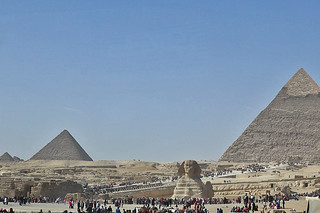
We came in through a temple near the Sphinx. I noticed the walls of the temple and I couldn't help but draw similarities to the walls built by the ancient Incas in Peru. Notice how there are almost no spaces in between the big slabs of stones?
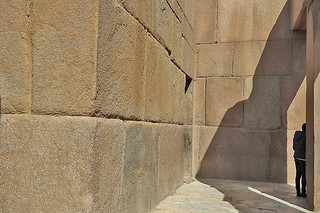
Finally, after a few steps going out from the temple we were face to face with the Great Sphinx. We were told that the Sphinx faces from West to East.
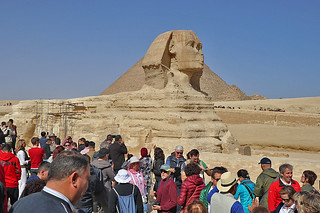
Here's a side view. The nose and other details have been weathered away. We were told that this monument used to be buried under the sand. It was excavated in the 1920s.
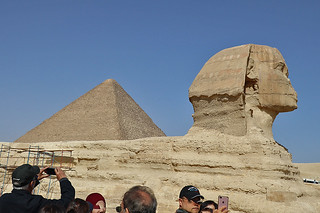
Here's the view from the back of the Sphinx.
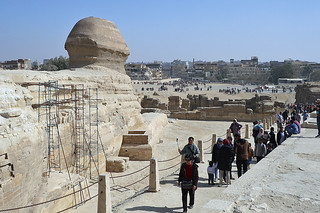
Here's the view from outside the complex on our way back to our tour bus.
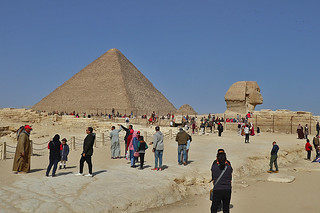
One of the evenings, there was an outdoor Light show and sounds in Giza. It tells the story of the pyramids with background narration while the lights and sounds are synchronized. This show actually happened the night before we went to see the Great Pyramids of Giza upclose.
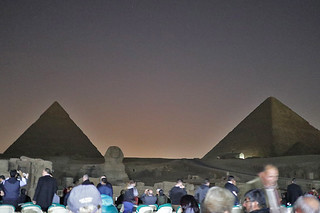
It was still winter when we went to Egypt. While the days maybe comfortably cool, the morning and nights were freezing. Here's the before the show started. We were seated for a long time waiting for the show to start. I could no longer bear the suspense.

Here's when the show started. The background music was very 50s era. It actually reminded me of the movie Ten Commandments. Maybe that was the effect the organizers are trying to create?
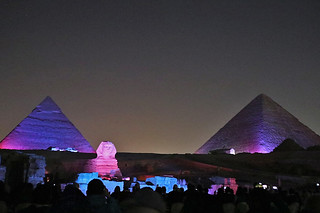
Here's the scene during the middle part of the story. By this time, it was getting to be a litte cheesy. I'd probably skip this tour if I knew what I know now.
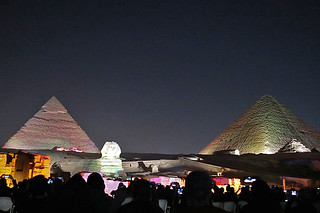
Here's the finale of the Sound and Light show.
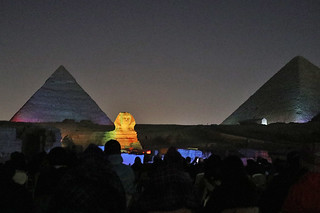
For a perspective, here's what the light and show venue looks like during the day. We were actually that close to the Great Pyramids and the Sphinx.

Our breakfast at the Marriot is mostly Western and some Asian.


However, there was a dessert that caught my attention. It is called Halawah. It is a sesame seed based sweet and it has this sweet nutty distinctive taste.

Another highlight of our Cairo trip was a visit to the Cairo Egyptian Museum. We were only given two hours inside the museum and half of the time was sort of a docent tour of the museum. The rest of the tour was a 30 minute time on our own.

It was overwhelming just looking at how much antiquities this museum is housing. I didn't think we were going to see a lot inside the museum with the very little time we were given.
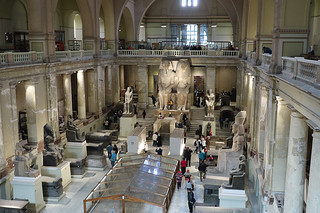
I've seen some Egyptian antiquities in other museums like the British Museum in London and the Metropolitan Museum in NYC so I kind of know what to expect. Nevertheless, Mijo and I were giddy like a little kid inside a candy store.

Here's one of two sides of Narmer's palette located at the Atrium in Room 43. It dates back from around 3100 BC depicting Pharaoh Narmer, also known as Menes, as the Pharaoh of both Upper and Lower Egypt. He was the first pharaoh of the 1st Dynasty - and the first in the 3000 years of Pharaonic history consisting of 170 Pharaohs ruling over 30 dynasties.
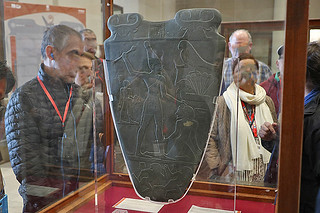
Here's a seated statue of King Chephren. Remember the Great Pyramids earlier in this blog? His pyramid was the one next to the Great Pyramid of Khufu. He is depicted here seated on his throne in smooth black diorite - a material harder than marble or granite.

Here's a statue of King Thutmosis III. He was the 6th Pharaoh of the 18th Dynasty or the period of the New Kingdom.

Here's a sample of a papyrus which is 9 meters long. We saw a demonstration of how to make papyrus earlier in the trip so I could kind of relate to this part of the tour.

Here's a sample details of that papyrus.

Here's the lid of King Akhenaten's coffin. Akhenaten was the husband of Queen Nefetiti.

Here's the glass bottom of King Akhenaten's coffin.

Here's the room with the artifacts from the Amarna period.

In my opinion, the superstar artifact in the museum is Tutankhamun's chamber and all the antiquities unearthed from it. They were discovered by English archeologist Howard Carter in 1922. Earlier in the trip, we visited the site where these antiquities were discovered in the Valley of the Kings in the West Bank of Luxor.

Here is one of artifacts recovered from the rediscovery of King Tut's chamber. It is a golden canopic shrine which contained canopic jars. The box is gilded with four goddesses, one of them is Isis, with arms outstretched as a sign of protection.

Inside the canopic box are the canopic jars where the stoppers look like the pharaoh's head. These jars contained the pharaoh's internal organs.

Here's a life sized statue of King Tut's.

Here's Tutankhamun's lion throne which is inlaid with golden sheets and precious stones.

Here's a wooden box where the panels are painted scenes showing the pharaoh hunting and fighting with enemies.

Here are some figurines or shabtis. Shabtis are attendants that are supposed to serve the pharaoh in the afterlife.

Here are restorations and renovations happening inside the museum.
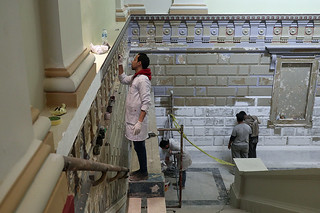
Here are the mummies. I don't want to scare most of you so I am not going to post the pictures of the mummies upclose.

Part of our Cairo sight seeing including a visit to a souq or market. We went to the Khan el Khalili Bazaar. I've been to the markets in Istanbul so I was curious what would be the difference between markets. The answer is they're kind of similar and yet each market is unique in their own way.

The market in Cairo is a mix of food, cafe, clothing, housewares, accessories, etc. The souq in Cairo looks more subdued compared to the ones in Istanbul. The souq in Cairo was also not inundated with tourists, which is a good thing.
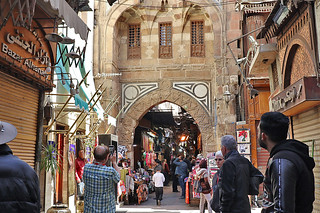
It is also an open air market so natural lights come in.

Families having a meal.

I wanted to bring one back home.

I noticed there were a number of bread vendors at the market.

Finally, we stopped for a coffee break.

Mijo and I also tried the restaurant in the hotel called Omar Cafe. The food was great. We tried the local fare - mousaka, fish with rice, pea soup and bread.




The hotel is on Gezira island in the middle of the Nile River. I tried to take pictures of the river every time our tour bus passed by one of the bridges. Here's a day photo.

Here's the Nile at dusk.

And here is the Nile at night. I can't imagine how this river used to look. This river has seen many centuries of Egyptian rulers and dynasties and common people.

Since we were touring most of the time and didn't have a free time to roam around the city on our own except on the first day. I wanted to see the Cairo Tower upclose. Nevertheless, I was glad I was able to see it from the tour bus.

Here's what a small segment of Cairo's skyline.

Since I like Halawah a lot, I bought some home with us for give aways to family and for us. These were my Egyptian souvenirs.

I am so grateful to have seen the antiquities in Cairo and the pyramids in Giza. I am so thankful to the visionaries who planned and designed the ancient city and the people who helped built so that visitors like me can enjoy seeing it five thousand years later.
This was an awesome experience and truly a dream come true.
~rl

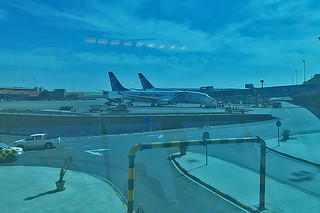
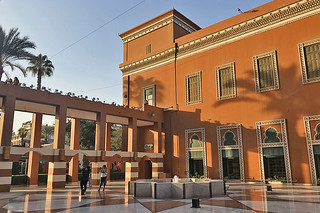
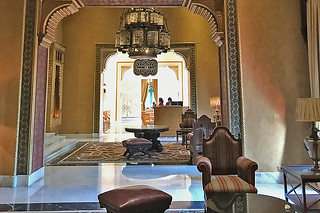
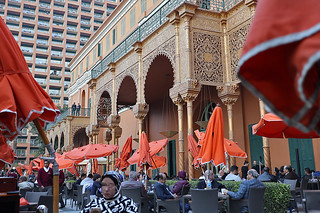
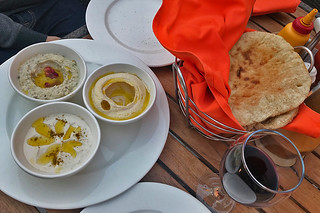
No comments:
Post a Comment